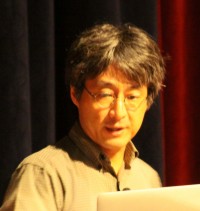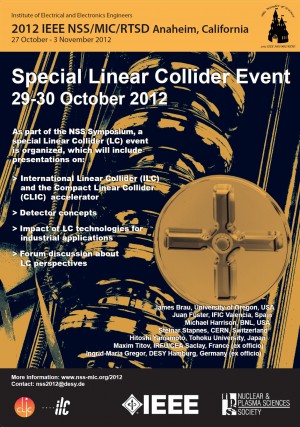The 2012 Institute of Electrical and Electronics Engineers (IEEE) Nuclear Science Symposium and Medical Imaging Conference, together with the Workshop on Room-Temperature Semiconductor X-Ray and Gamma-Ray Detectors was held in at the Disneyland Hotel (Anaheim California), from 29 October to 3 November. A feature of this year’s symposium was a “Special Linear Collider Event.” The special event came on the heels of the discovery of the Higgs-like particle at CERN’s LHC and had an array of leaders in the field. There were presentations on the International Linear Collider (ILC) and Compact Linear Collider (CLIC) accelerator as well as detector concepts, the potential impact of the LC technologies for industrial applications and a forum discussion about future LC perspectives.
We particle physicists work in a very exciting field, where our discoveries now make front-page news around the world. But, our field is also very expensive, requires huge particle accelerators and large sophisticated detectors to push its frontiers. The LHC is a wonderful example of worldwide collaboration to jointly build such a very large forefront instrument and then jointly pursue the science. The community is now contemplating future machines beyond the LHC, including a complementary electron linear collider like the ILC. To realise our ambitions, we must convince our fellow scientists and engineers of these investments. The IEEE Special Linear Collider Event was just such an opportunity to present the science and technology of linear colliders to this important community, and in that respect we put our best foot forward.
The IEEE Nuclear Science Symposium series started in 1954 and has become one of the largest annual events in the areas of nuclear and particle physics instrumentation, along with the IEEE Medical Imaging Conference (MIC). The one-week meeting typically attracts more than 2,000 leading detector physicists, engineers and industrial companies from all over the world.

Hitoshi Murayama, Director of the Kavli Institute for the Physics and Mathematics of the Universe, Tokyo
A highlight of the event was a featured talk by Hitoshi Murayama on Physics of the Linear Colliders that appealed to both the broader audience at IEEE and to those of us involved in the field. We are very fortunate that Hitoshi has agreed to be part of the new Linear Collider management that will replace the present ILC organisation and integrate the ILC and CLIC efforts, following the completion of the ILC Technical Design Report.
The two-day Special Linear Collider (LC) Event was organised as part of this year’s NSS Symposium, and included presentations on both the International Linear Collider and the Compact Linear Collider accelerator, detector concepts, the impact of LC technologies for industrial applications, and a forum discussion on LC perspectives. The reviews of ILC and CLIC traced the history of developing the concepts and technologies, and the associated talks on industrial applications were tailored for this audience. Finally, the special event ended with a forum discussion that included Rolf-Dieter Heuer, CERN, Joachim Mnich, DESY, Atsuto Suzuki, KEK, Stuart Henderson, Fermilab, Steiner Stapnes, CERN, Akira Yamamoto, KEK, and Hitoshi Yamamoto. The round table discussion began with Atsuto Suzuki presenting the context of the recent discovery of the Higgs-like particle at CERN and the emerging initiative toward a linear collider in Japan. The discussion then focused on issues like organising global collaboration, involving industry, technology transfer and impacts on society.
On behalf of our LC community, I would like to thank Maxim Titov, 2012 IEEE NSS Program Chair, and Ingrid-Maria Gregor, 2012 IEEE NSS Deputy Program Chair, for organising this very interesting symposium.




Recent Comments